Old Warden Church Repairs and Additions
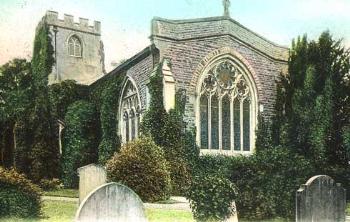
Church from the east about 1900 [X758/1/12/102]
The lowest stage of the tower of Saint Leonard's church is 12th century but it was rebuilt in the 15th century and the upper three stages of the tower are all of that date. Work was also carried out in the next century as there are 16th century square-headed three light windows to the south-east and west in the south aisle. One of the bells was cast late in the 16th century.
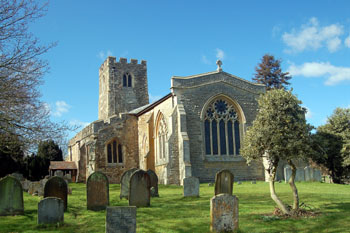
Church from the east March 2008
Most of the structural history of the church can be found in detail in Bedfordshire Historical Record Society Volume number 79 of 2000 Bedfordshire Churches in the Nineteenth Century: Part III: Parishes S to Y, put together by former County Archivist Chris Pickford from numerous sources some held by Bedfordshire & Luton Archives & Records Service and some held elsewhere or published. In 1617 the chancel was said to be out of repair [ABC5 page 214] and three bells were cast for the church between 1623 and 1653.

Sir Samuel Ongley's monument July 2007
The most prominent feature of the 18th century in the church is the monument to Sir Samuel Ongley [died 1726] by P.Scheemakers and L.Delvaux, for which a faculty was granted in 1728 for erection in place of a pew at the west end of the church [ABF3/211]. In 1787 a faculty was granted for the construction of the Ongley vault and mausoleum in the churchyard [ABF3/212-213].
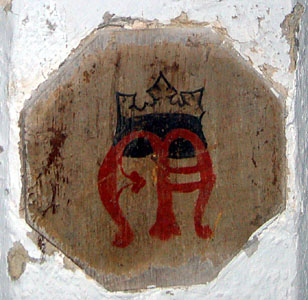
Survival from the former Abbey on a column in the south arcade march 2008
In 1822 a terrier recorded that the ancient plate had been stolen in March 1821 [ABE5]. In 1827 the church had a small organ and the notebook of Archdeacon notes that the chancel was repaired in 1836.
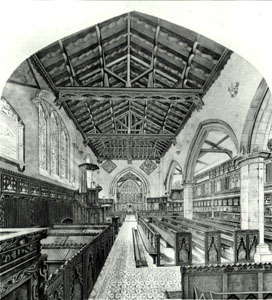
Interior of church looking east drawn by John Sunman Austin 1854 [Z50/129/37]
It was in 1841 that the largest change to the church since the Middle Ages occurred. Nikolaus Pevsner in his Buildings of England volume for Bedfordshire notes, in rather horrified fashion: "There is nothing in this exterior to prepare for the shock in store upon entering. One can only just register the high unmoulded Norman tower arch…before going under in a mass of woodwork indiscriminately got together by Robert Henley, Lord Ongley, in 1841…It oppresses you from all sides; it is utterly disjointed…" The 3rd Baron Ongley crammed in woodwork from England and Flanders varying in date from the 16th to the 18th century; there is a Jacobean gallery in the south aisle and a hotchpotch of 16th and 17th century Belgian panels making up the box pews. To some it is oppressive, to others wonderfully eclectic and charmingly cluttered. Whatever one's view it is not quickly forgotten.
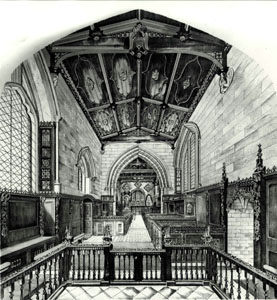
Interior of church looking west drawn by John Sunman Austin 1854 [Z50/129/38]
As well as shoe-horning in all this woodwork the roof of the nave was also rebuilt in 1841 and a new barrel organ installed in the gallery in 1842, which was replaced by a harmonium bought by subscription in 1876 [P105/8/1]. In 1872 the Shuttleworths succeeded the Ongleys as the principal landowners in the parish and, almost in a spirit of needing to do something to keep up with his predecessor, Frank Shuttleworth installed an 18th century pulpit from Edinburgh into the creaking mass of 16th to 18th century woodwork in the 1880s [ABE3]. He also gave a new organ in 1887 and a chamber on the north side of the chancel to put it in [P105/8/1].
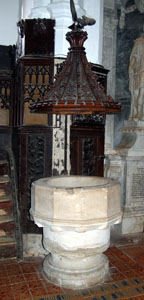
The font March 2008
John Martin was librarian of Woburn Abbey and wrote a series of scathing articles for the Northampton Mercury either side of 1850 on individual churches in Bedfordshire. His articles tend toward the pompous, the sarcastic and the vituperative. He seems to have found Saint Leonard's more agreeable, however.

Abraham and Isaac March 2008
"The rich man's duty to contribute liberally to the building, repairing, beautifying, and adorning of churches has, in the instance of this church been most effectually performed. The solemn air, and the grateful impression which the mind of the spectator receives on his entrance form a striking contrast to the chilling effect produced by masses of whitewash, and the appearance of neglect and decay. The rich decorations, the costly specimens of carving and the delightful order which prevail throughout this elaborately ornamented building, render it one of the bright spots among the miserably neglected churches of the county. We hope that the example will have ere long many followers, "in an age wherein many of our churches, if by no other causes, yet by bare length of time, are become so far decayed as to stand in need, either of being wholly rebuilt, or else very much repaired"
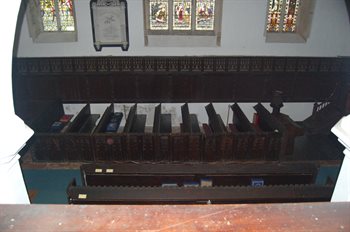
View from the gallery showing the pews March 2008
"Where the noble desire to render this House of Prayer worthy of the purpose for which it is intended has been so unbegrudgingly carried out, it is not without reluctance that we touch upon any blemished, but as honest chroniclers we must be permitted a few remarks which occurred on our inspection. We were sorry to see, beautifully decorated as they are, enclosed pews. Their selfish appearance detracts considerably both from the effect of the interior and the pleasure derived from the general aspect. The singing gallery with the organ, as well as shutting out the western window, protrude most unpleasantly. In so small a building, surely the well-trained choir of this parish could easily spare the instrument. Relieved from this and the gallery, the effect would be greatly improved".
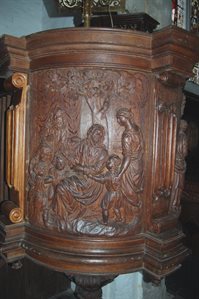
The pulpit March 2008
"The pulpitand reading desk occupy sorry positions. By the abolition of the latter puritanical introduction [John Martin was an Anglo-Catholic], and placing the pulpit in its right quarter, space would be gained possibly sufficient to obviate the necessity for the enclosed pews in the chancel, always objectionable; but if sittings must be in that portion of the church , stalls would be far less offensive, and in great degree remove the indecorum of the back of the occupant being turned to the Altar. And we would most earnestly wish that the monument in a Roman dress [the monument to Sir Samuel Ongley] could be removed to the sculpture gallery; here it is sadly out of keeping".
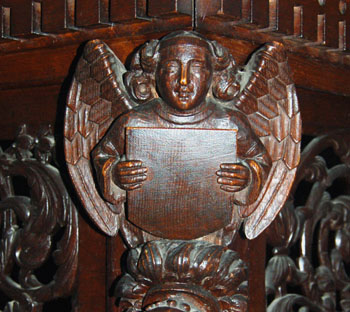
Angel carving April 2007
"Deeply shall we regret that any remarks which we have been inducedto make, shall appear, in the slightest degree, to detract from the tribute of respect, however humble, we most earnestly desire to offer to the noble author of the beautiful and costly improvement which this church has received at his hands, and who has left a memorial of his deeds, in the spirit of that "high philosophy, which tells him he has not given in vain"".
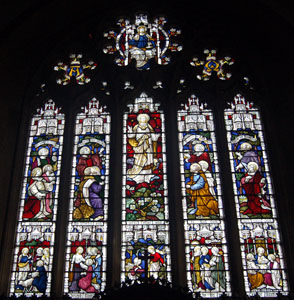
The east window March 2008
Between 1888 and 1889 the chancel was restored by Samuel Whitbread [P105/8/1], the east end was completely rebuilt and Caroline Shuttleworth paid for a new stained glass east window as a memorial to Joseph Shuttleworth who had died in 1883. This began a trend and over the next fifteen years most of the windows were filled with stained glass as memorials to various Shuttleworths, Caroline herself died in 1899 and is commemorated by a window on the south side of the chancel. In that year the bells were restored and increased to six in number [P105/2/2/2]. Two years later a vestry was built onto the north side of the church to designs of Charles Hodgson Fowler of Durham [X428/4].
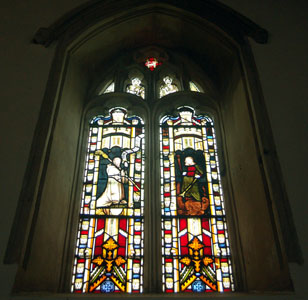
Nave north wall east window - March 2008
In the 20th century the tower and south aisle were repaired in 1935 [P105/2/2/5] and in the same year 14th century restored glass from Warden Abbey was installed in the north-east nave window [P105/2/2/5]. In 1952 a south porch was erected in memory of Richard Ormonde Shuttleworth, a pilot officer in the RAF Volunteer Reserve who died on 2nd August 1940, aged 31, and is buried in the churchyard [P105/2/2/11-17]. The church underwent extensive repairs by Ampthill architects Richardson and Houfe between 1955 and 1956.

Church interior looking east April 2007
In March 1997 much of the carved woodwork inside the church was stolen. Whether this was for money or by someone who felt it oppressed them is not clear.
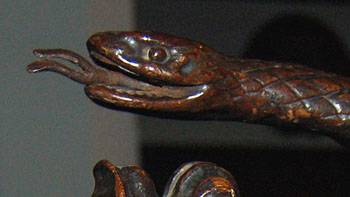
A snake head from one of the pews April 2007